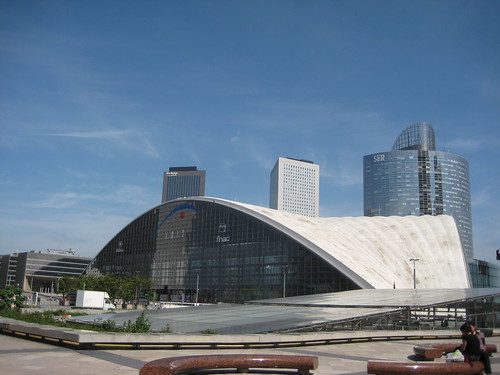
The Center of New Industries and Technologies (CNIT) was built and first used in 1958. These "first generation" skyscrapers were all very similar in appearance, limited to a height of 100 metres (330 ft). In 1966, the Nobel Tower was the first office building built in the area. In 1970 the RER line A railway was opened from La Défense to Étoile. In the early 1970s, in response to great demand, a second generation of buildings began to appear, but the economic crisis in 1973 nearly halted all construction in the area. A third generation of towers began to appear in the early 1980s. The biggest commercial centre in Europe (at the time), the Quatre Temps, was created in 1981. In 1982, the EPAD launched the Tête Défense competition to find a monument to complete the Axe historique, which eventually led to the construction of Grande Arche at the west end of the quarter. During the same period, hotels were constructed, the CNIT was restructured, and in 1992 Line 1 of the Paris Métro was extended to La Défense, which made the area readily accessible to even more of the city.

Aiman and my husband inside CNIT.

Infront of Grande Arche. The open lift is in the middle of the building going to the top. A great national design competition was launched in 1982 as the initiative of French president François Mitterrand. Danish architect Johann Otto von Spreckelsen (1929–1987) and Danish engineer Erik Reitzel designed the winning entry to be a 20th century version of the Arc de Triomphe: a monument to humanity and humanitarian ideals rather than military victories. The construction of the monument began in 1985.
The Arche is almost a perfect cube (width: 108m, height: 110m, depth: 112m); it has been suggested that the structure looks like a four-dimensional hypercube (a tesseract) projected onto the three-dimensional world. It has a prestressed concrete frame covered with glass and Carrara marblefrom Italy and was built by the French civil engineering company Bouygues.
The two sides of the Arche house government offices. The roof section, exploited by Stephane Cherki, is an exhibition centre. The vertical structure visible in the photograph is the lift scaffolding. Views ofParis are to be had from the lifts taking visitors to the roof.

In Paris, we are staying in La Defense. It was transformed into a commercial area starting from 1958. In La Defense, the scenario is different. No more medieval buildings but modern skyscrapers. Technip building is one of them. My husband is currently working in Technip Paris for a short stint. The Grande Arche you can see in the middle is in vertical line with the historic Arc de Triomphe far away. A splendid town planning.

Aiman and my husband walking along the vast concrete area. There's a few artistic sculpture like the one on the left. Buildings in France are never really square. Either they are triangle or even if they are square, they are not cut at 90 degrees exactly. The edge looks like 60 degrees or something like that. The commercial buildings don't have curtain to cover its glass wall. So everything is transparent. No hanky panky business inside the office.

Aiman and my husband in front of the 'finger'. You can see the details in the sculpture with all the lines. Wonder how they mould it to the exact grid.

There a big railway station underneath all the big buildings. In Paris the trains move underground.


No comments:
Post a Comment